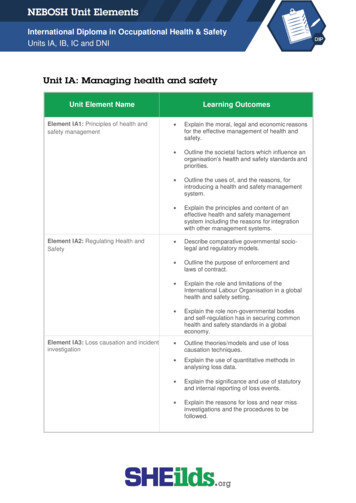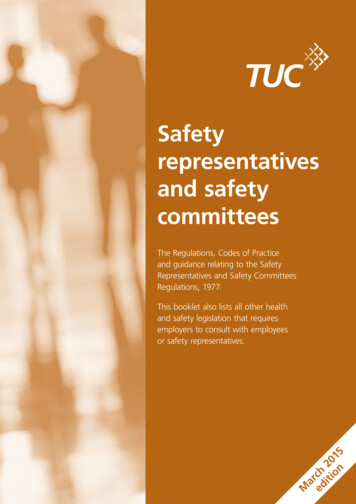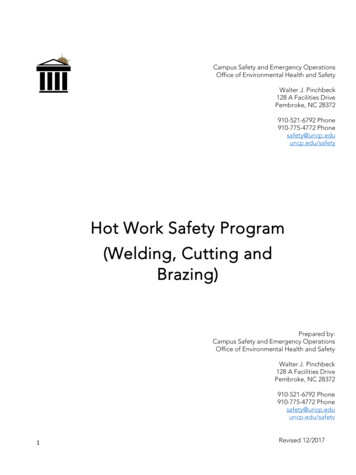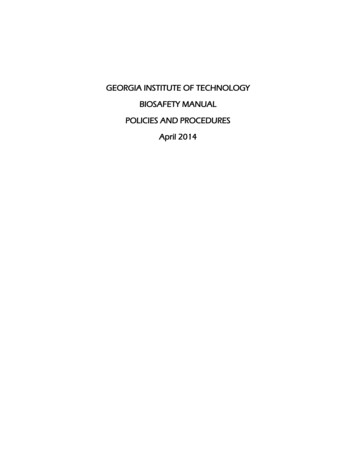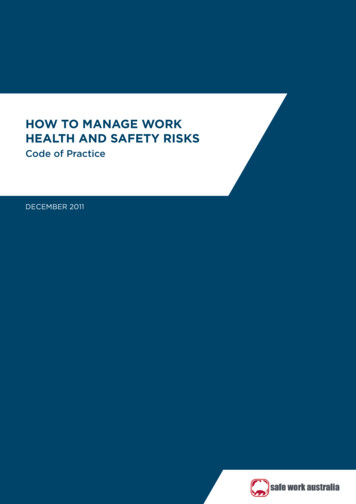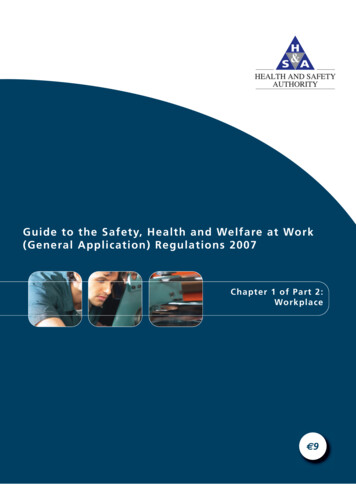
Transcription
Guide to the Safety, Health and Welfare at Work(General Application) Regulations 2007Chapter 1 of Part 2:Workplace 9
Workplace:Layout 130/11/200710:00Page 1Guide to theSafety, Health and Welfare at Work(General Application)Regulations 2007Chapter 1 of Part 2:Workplace
Workplace:Layout 130/11/200710:00Page 2Published in December 2007 by the Health and Safety Authority, The Metropolitan Building, James Joyce Street, Dublin 1. All rights reserved. No part of this publication may be reproduced, stored in a retrieval system, or transmitted in any formor by any means, electronic, mechanical, photocopying, recording or otherwise, without the prior permission of the Healthand Safety Authority.
Workplace:Layout 130/11/200710:00Page 3Introduction5Regulation 4: Interpretation for Chapter 16Regulation 5: Stability and Solidity7Regulation 6: Ventilation of Enclosed Places of Work7Regulation 7: Room Temperature8Regulation 8: Natural and Artificial Lighting11Regulation 9: Floors, Walls, Ceilings and Roofs of Rooms12Regulation 10: Windows and Skylights15Regulation 11: Doors and Gates16Regulation 12: Emergency Routes and Exits18Regulation 13: Fire Detection and Fire Fighting19Regulation 14: Movement of Pedestrians and Vehicles in Danger Areas21Regulation 15: Specific Measures for Escalators and Travelators23Regulation 16: Loading Bays and Ramps23Regulation 17: Room Dimensions and Air Space in Rooms andFreedom of Movement at the Workstation24Regulation 18: General Welfare Requirements25Regulation 19: Rest Rooms and Rest Areas27Regulation 20: Sanitary and Washing Facilities28Regulation 21: Changing Rooms and Lockers30Regulation 22: Accommodation Areas at a Place of Work31Regulation 23: Outdoor Places of Work, Special Provisions32Regulation 24: Pregnant, Postnatal and Breastfeeding Employees32Regulation 25: Employees with Disabilities32Regulation 26: Agreements as to a Premises Used as a Place of Work33Appendix: Sources of Further Information and Bibliography35WorkplaceContents
Workplace:Layout 130/11/200710:00Page 4
Workplace:Layout 130/11/200710:00Page 5Regulations 2007Chapter 1 of Part 2: WORKPLACEIntroductionWorkplaceGuide to Chapter 1 of Part 2 of the General ApplicationRegulations 2007This Guide is aimed at safety and health practitioners, employers, managers,employees, safety representatives and others to give general guidance on Chapter 1of Part 2 (Regulations 4 to 26) of the Safety, Health and Welfare at Work (GeneralApplication) Regulations 2007 (S.I. No. 299 of 2007) relating to the workplace.It is not intended as a legal interpretation of the legislation.From 1 November 2007, Chapter 1 of Part 2 of the General Application Regulations2007 re-transposes Directive 89/654/EEC and replaces Part III (Regulations 16 and17) of the Safety, Health and Welfare at Work (General Application) Regulations1993 (S.I. No. 44 of 1993), which are revoked from that date.In this Guide the text of the Regulations is shown in italics.The General Application Regulations 2007 are made under the Safety, Health andWelfare at Work Act 2005 (No. 10 of 2005) referred to elsewhere in this Guide as“the Act” or the “2005 Act”.In summary, Chapter 1 of Part 2 of the General Application Regulations deals withthe physical environment at the place of work and sets out the welfare facilitieswhich should be provided as standard facilities for a premises used as a workplace.Working in fields or forestry undertakings is not covered by the Regulations,except for workshops and buildings associated with them. The provisions apply toall buildings used as places of work with the following exemptions: Means of transport used outside the undertaking Mobile or temporary work sites including construction sites Extractive industries Fishing boats.Several of these are covered, or will be covered, by other Regulations.The employer must ensure that the physical environment of the place of work isadequate. Work areas should be large enough to be safe and healthy and beadequate with regard to stability, ventilation, fresh air, temperature and lighting.Pedestrians and vehicles must be able to circulate safely. Traffic routes, entrancesand exits must be kept clear. Floors, walls, ceilings, roofs, doors, gates, loadingbays and ramps must be safe.5
Workplace:Layout 130/11/200710:00Page 6Guide to the Safety, Health and Welfare at Work (General Application)Adequate toilet, washing and welfare facilities must be provided.Employees working outdoors should be protected against bad weather, noise, slippery conditions etc.Arrangements for pregnant and breastfeeding employees to lie down must be available.Where necessary, the workplace must be organised to take account of workers with disabilities.As it is not possible for this Guide to address all the issues that may arise in respect of a workplace,references to further sources of information are provided in the Appendix to assist persons to makepractical judgments where the Regulations have been framed in general terms.Regulation 4: Interpretation for Chapter 14.In this Chapter—“place of work” means a place of work intended to house workstations on the premises of anundertaking and any other place within the area of the undertaking to which an employee hasaccess in the course of his or her employment but does not include—(a) means of transport used outside the undertaking or a place of work inside ameans of transport,(b) temporary or mobile work sites, including construction sites,(c) extractive industries,(d) fishing boats,(e) fields, woods and land forming part of an agricultural or forestry undertaking but situatedaway from the undertaking’s buildings.The requirements of Chapter 1 of Part 2 of the General Application Regulations apply to all places ofwork which are located within a premises in which work is carried out on or within the boundaries ofthe premises, except those places listed at (a) to (e) above.This particular definition of “place of work” is for Chapter 1 of Part 2 only and covers not only theplace where the work actually takes place but also rest areas, toilets, changing rooms etc. The broaderdefinition found in the 2005 Act applies where the term is used elsewhere.In respect of the places which are excluded from this Chapter, it should be noted that there is still ageneral duty to ensure the safety, health and welfare of workers arising from the 2005 Act, the otherprovisions of the General Application Regulations 2007 and other relevant legislation.The exemption related to agriculture or forestry does not extend to the buildings used by workers inthose sectors.6
Workplace:Layout 130/11/200710:00Page 7Regulations 20075.An employer shall ensure that buildings which house places of workshall have a structure and solidity appropriate to the nature of their use.The employer must be satisfied that the floors, walls etc. of the place of work areable to support both the weight of equipment and the pressures of additional forceswhich its use imposes on the structure.WorkplaceRegulation 5: Stability and SolidityThe structure’s materials, where possible, should also be suitable for the workundertaken so that over time it does not fail; for example, floors rotting due tomoisture or corrosion of structural steel supports. Where such risks have beenidentified, ongoing periodic examination will be necessary to detect any signs ofdeterioration.In some workplaces there will be risks to the structure from impact damage causedby moving vehicles and measures need to be taken to protect vulnerable areas andto repair any damage before it poses a hazard to safety.The installation of new equipment in existing buildings may require an analysis todetermine if structural changes are necessary.If cracks occur in the structure, they need to be investigated to ascertain if there is arisk to safety.Regulation 6: Ventilation of enclosed places of work6.An employer shall ensure that—(a) sufficient fresh air is provided in enclosed places of work, havingregard to the working methods used and the physical demands placedon the employer’s employees,In most cases the natural ventilation provided through windows and doors will beadequate. In cases where, for instance, there are high dust levels or hightemperatures or where the workplace is isolated from the outside air, mechanical orforced ventilation may be necessary.The provision of natural or forced ventilation will depend on the: Processes, materials and substances which are liable to contaminate theatmosphere, released heat or humidity Design of the building Volume of the workplace itself Number of occupants, including any animals7
Workplace:Layout 130/11/200710:00Page 8Guide to the Safety, Health and Welfare at Work (General Application) Physical activity of the occupants or any animals Location of a workstation within a building.(b) if a forced ventilation system is used, it is maintained in working order and anybreakdown is indicated by a control system if necessary for the safety and healthof employees,Mechanical ventilation systems should be maintained in good working order as part of a plantmaintenance system.The requirement for a device to give warning of breakdowns applies where necessary for reasons ofsafety and health. It could apply particularly to “dilution ventilation” systems used to reduceconcentrations of dust or fumes in the atmosphere. It could also apply to any other situation where abreakdown in the ventilation system would be likely to result in harm to employees.The system should be designed so that the breakdown is readily detected by those liable to be affected.Alarms in rarely visited plant rooms would not be adequate.(c) if air-conditioning or mechanical ventilation installations are used, they operate in sucha way that employees are not exposed to draughts which cause discomfort, andThe sensation of draughts is related to air speed and temperature, a person’s activity and level ofclothing. It can also be related to the sensitivity of the individual concerned. Draughts may be causedby inadequate design or control of the ventilation system or poor workstation layout arrangements.(d) any deposit or dirt likely to create an immediate danger to the safety and health ofemployees by polluting the atmosphere is removed without delay.Systems should be free from any substance or organism which may contaminate the air passing by it,thereby affecting the safety and health of employees. Hazards may arise from spillages of work-relatedmaterials, bird/bat droppings near air intakes or the growth of microbial contamination in ductwork.Detailed advice on the cleaning of ventilation systems has been published by a number of bodiesincluding the Chartered Institution of Building Services Engineers (CIBSE).Regulation 7: Room temperature7.(1) An employer shall ensure that—(a) during working hours, the temperature in rooms containing workstations is appropriatefor human beings, having regard to the working methods being used and the physicaldemands placed on the employees,(b) for sedentary office work, a minimum temperature of 17.5 C, so far as is reasonablypracticable, is achieved and maintained at every workstation after the first hour’s work,8
Workplace:Layout 130/11/200710:00Page 9Regulations 2007(d) means are available to enable persons at work to measure thetemperature in any workplace inside a building,Workplace(c) for other sedentary work, at every workstation where a substantialproportion of the work is done sitting and does not involve seriousphysical effort, a minimum temperature of 16 C is, so far as isreasonably practicable, achieved and maintained after the firsthour’s work,The temperature in rooms in which employees work must be adequate havingregard to the: Indoor or special work clothing normally worn by the employees Physical activity involved in the work Other elements of the thermal environment, such as radiant heat,humidity and air movement Need for any special conditions arising from, or required for, the workbeing carried out, such as heat, cold, humidity etc.In cases where it is difficult to maintain an adequate overall temperature, it may benecessary to provide effective local heating, protective clothing or cooling atindividual workstations.Care needs to be taken with temporary heaters so as to prevent burns from contactwith hot surfaces. No heating method should be employed which results in theescape into the air of any workroom of any fume of such character and to suchextent as to be likely to be injurious or offensive to employees therein.The General Application Regulations 1993 (S.I. No. 44 of 1993) did not citespecific temperatures, leading to some uncertainty as to what was legally requiredor enforceable when dealing with temperature issues; the situation has beenclarified by the specification of some values in these Regulations.The fact that a maximum temperature has not been specified in the Regulationsdoes not mean that any temperature is acceptable. At high or uncomfortabletemperatures, especially when not caused by temporary weather conditions, ameans of cooling should be provided.The temperature levels in Regulation 7(1)(b) and (c) are not comfort temperaturesand do not represent temperatures at which people can work most efficiently.The determination of appropriate temperatures is addressed in ISO standard 7730 –“Ergonomics of the thermal environment – Analytical determination andinterpretation of thermal comfort using calculation of the PMV and PPD indicesand local thermal comfort criteria” – which is available as an Irish standard I.S. ENISO 7730:2005. This is a complex document most likely to be used at the designstage or during a technical investigation of a complaint.9
Workplace:Layout 130/11/200710:00Page 10Guide to the Safety, Health and Welfare at Work (General Application)It is suggested that for most people an acceptable temperature for office work lies within the range of18 to 23oC. Recommendations for different building uses are available in guidance from CIBSE.Advice on dealing with heat and cold stress is available from the American Conference ofGovernmental Industrial Hygienists (ACGIH) or the British Occupational Hygiene Society.Workers are entitled to have some means readily available to them to measure the temperature. Inpractice, this means that if an employee wants to measure the temperature there will be a thermometerreadily available.(e) the temperature in rest areas, rooms for duty staff, sanitary facilities, canteens and firstaid rooms is appropriate to the particular purpose of such areas, andIn parts of the workplace other than workrooms, such as sanitary or rest facilities, the temperatureshould be reasonable in all the circumstances including the length of time people are likely to be there.Changing rooms and shower rooms should be adequately heated.(f) in relation to windows, skylights and glass partitions, excessive effects of sunlight areavoided in places of work, having regard to the nature of the work and thecharacteristics of the place of work.Excessive heat from the sun shining through windows, skylights or glass partitions must be avoided.This can be achieved by various means including internal blinds, external blinds, use of low-emissivityglass, whitewashing of windows etc.(2) The temperature referred to in paragraphs (1)(b) and (c) shall be a dry bulbtemperature taken at the working position of the employee at 1.1 m above thefloor surface.This provision standardises the method for measuring the air temperature as there is likely to be atemperature gradient in any room between the floor and the ceiling. A dry bulb temperature is onemeasured by a liquid-in-glass or digital thermometer.(3) Where, due to process requirements, a workplace temperature below 16 C is necessary,the employer shall assess the risks and take any necessary measures to ensure thesafety, health and welfare of the employer’s employees.Legislation for food hygiene may result in work at low temperatures and in such, or similar,circumstances the employer needs to determine how to minimise such exposures. Where this is notpossible, the employer must conduct a risk assessment to determine what is necessary for employeeprotection. Issues for consideration include degree of exposure, task rotation, local heating, heated restfacilities, insulation from cold surfaces, personal protective clothing and equipment etc. Finally,whatever work practices are adopted must provide a safe work environment.The ACGIH recommends special protection of the hands to maintain manual dexterity and preventaccidents if fine work has to be performed with bare hands for more than 10 to 20 minutes in anenvironment below 16oC. Clearly, the precautions must take account of the work hazards, i.e. glovesmay be appropriate for some applications but not others.10
Workplace:Layout 130/11/200710:00Page 11Regulations 20078.An employer shall ensure that—(a) places of work receive, as far as possible, sufficient natural light andare equipped with artificial lighting adequate for the protection ofthe safety and health of the employer’s employees,WorkplaceRegulation 8: Natural and artificial lightingWhilst the provision of natural lighting takes precedence over artificial lighting, inpractice both will be required. Artificial lighting should be adequate and properlymaintained for the safety and health of persons at work. To maximise the use ofnatural lighting, windows, skylights and glass partitions used for lightingworkrooms should be kept clean on both inner and outer surfaces.The lighting levels should be sufficient to enable persons to detect obvious hazardsas well as being able to work without experiencing eyestrain.Lighting arrangements should be made so that brightness, unsuitable shading orpoorly placed light sources or workstations cannot cause discomfort or injury fromglare or from reflection of light into the eyes of the employees.Determining what is good and correct lighting depends on the visual demands ofthe task to be performed and the nature of the work to be performed, i.e. officework, hospital work, inspection of minute work (jewellery and watch-making), finebench and machine work, rough bench work etc. Standards set by recognisedprofessional bodies, such as CIBSE, should be referred to as regards determiningthe correct level of lighting.(b) lighting installations in rooms containing workstations and inpassageways are placed in such a way that there is no risk ofaccident to the employer’s employees as a result of the type oflighting fitted, andLights and light fittings should be of a type, and so positioned, that they do notcause a hazard (including electrical, fire or collision hazards). Glare and dazzleshould be avoided. Light switches should be positioned for easy access and usewithout risk.Lights should not be allowed to become obscured, for example by stacked goods orappliances, in such a way that the light level is inadequate.In some cases extra physical protection of light sources may be necessary toprevent the possibility of electrocution where there is a risk of physical impact, e.g.if located in pits or areas where metal tubing is being handled.(c) places of work in which the employer’s employees are especiallyexposed to risks in the event of failure of artificial lighting areprovided with emergency lighting of adequate intensity.11
Workplace:Layout 130/11/200710:00Page 12Guide to the Safety, Health and Welfare at Work (General Application)Emergency lighting is necessary if employees are put at risk in the event of any failure of the normallighting system. Such risks include panic, falling down stairs, tripping, collision with objects and lossof sense of direction.Guidance on emergency escape lighting can be found in the following publications:(a) Technical Guidance Document B to the Building Regulations(b) Lighting Applications Emergency Lighting, I.S. EN 1838:1999(c) Code of Practice for Emergency Lighting, I.S. 3217:1989.Regulation 9: Floors, walls, ceilings and roofs of rooms9.(1) An employer shall ensure that—(a) the floors of rooms have no dangerous bumps, holes or slopes and are fixed,stable and, so far as is reasonably practicable, not slippery,The surfaces of floors and traffic routes should be free from any hole, slope or uneven or slipperysurface which is likely to cause: A person to slip, trip or fall A person to drop or lose control of anything being lifted or carried Instability or loss of control of vehicles or their loads (or both).Slopes should not be steeper than necessary. Moderate and steep slopes should be provided with asecure handrail, where necessary.Floor surfaces which are likely to become wet or to be subject to spillages should be of a type whichdoes not become unduly slippery. Where there is likely to be danger, protection should be provided, forexample through protective footwear, slip-resistant floor surfaces, barriers around areas being cleaned,proper cleaning techniques and adequate maintenance.The report Safer surfaces to walk on – reducing the risk of slipping, published by the UK ConstructionIndustry Research and Information Association (CIRIA), provides useful information for designers andbuilding maintenance managers.(b) the surfaces of floors, walls and ceilings in rooms are such that they can be cleaned orrefurbished to an appropriate standard of hygiene,Floors, ceilings and interior walls should be painted, tiled or otherwise treated so that they can be keptclean. The surface treatment should be renewed when it can no longer be cleaned properly. Absorbentfloors, such as untreated concrete or timber, which are likely to be contaminated by oil or othersubstances which are difficult to remove, should be sealed or coated, for example with a suitable nonslip floor paint. Interior walls, floors, ceilings and work surfaces must be cleaned at suitable intervals.The intervals will depend on the type and level of work activity and the frequency of use. Cleaning12
Workplace:Layout 130/11/200710:00Page 13Regulations 2007For some places of work, the selection and cleaning of floors and walls may also besubject to food hygiene requirements, set by the Food Safety Authority of Ireland.(c) access to roofs and suspended ceilings made of materials ofinsufficient strength is not permitted unless—(i) equipment is provided to ensure that the work can be carriedout in a safe manner, and(ii) appropriate warning signs in accordance with Part 7,Chapter 1 are placed at such access points,Workplaceshould be carried out by an effective and suitable method and without creating ahealth or safety risk for employees.Roofs containing fragile materials include the following: Profiled plastic cladding Glass reinforced plastic (GRP) daylight sheets Asbestos cement sheets Fibre cement sheets (non-asbestos) (v) Glass-wired or plain Light-gauge steel sheets Other fragile materials used for roofing.Access to roofs is often a feature of maintenance work and the provisions of Part 4 ofthe General Application Regulations 2007 relating to work at height will be relevant.Persons at work may not be allowed to: Pass across or work on or from a fragile surface where it is reasonablypracticable to carry out work safely without their doing so Enter onto any roof which incorporates fragile material and which wouldbe liable to fracture under weight, unless protective measures are taken,for example use of ladders, crawling ladders, crawling boards orduck boards Work near, or to pass by, fragile parts of a roof unless suitable protectivemeasures are taken, for example guard rails, coverings or other suitablemeans to prevent them stepping on or falling through the roof shouldthey lose their balance.Prominent warning notices must be posted where there is access to, or where anyperson at work passes across or near, any fragile roof. In addition, a verbal warningmust be given to any employees who may require such access.13
Workplace:Layout 130/11/200710:00Page 14Guide to the Safety, Health and Welfare at Work (General Application)(d) transparent and translucent walls, in particular all-glass partitions, in rooms or in thevicinity of workstations and traffic routes are—(i)clearly indicated,(ii) made of safety material, or(iii) shielded from such places or traffic routes,to prevent employees from coming into contact with the walls or being injured should thewalls shatter, andA translucent wall is one that is semi-transparent.The first requirement is to ensure that persons will be able to note the presence of a transparent walland not confuse it for an opening through which they may expect to pass.Transparent or translucent walls and partitions should be made of materials which are safe or theyshould be adequately protected against breakage, particularly where any part of the transparent ortranslucent surface is at waist level (800 mm from floor level) or below.Detailed guidance related to glazing and human impact can be found in BS 6262-4:2005 “Glazing forbuildings: Code of practice for safety related to human impact”.As an alternative to the use of safety materials, transparent or translucent surfaces may be adequatelyprotected against breakage. This may be achieved by means of a screen or barrier which will prevent aperson from coming into contact with the glass if he or she falls against it.A transparent or translucent surface should be marked, where necessary, to make it apparent. Where itis needed, marking may take any form (for example coloured lines or patterns) provided that it isconspicuous and at a conspicuous height.In all glass structures, such as glasshouses, employees should be instructed in the necessary safetyprecautions to avoid contact and injury from glass.(e) places of work containing workstations are adequately thermally insulated, bearing inmind the type of undertaking involved and the physical activity of the employees.(2)Paragraph (1)(e) does not apply to places of work in use prior to 31 December1992 except as regards modifications, extensions or conversions made afterthat date.Adequate thermal insulation in the context of these Regulations relates to securing an appropriatetemperature for employees. The application of this Regulation depends on determining the adequacy ofthe existing arrangements and, if inadequate, what impact any change in thermal insulation wouldhave. In buildings where, of necessity, large doors are kept open for most of the time, a change inthermal insulation would have little impact on worker wellbeing though there may still be options forlocal draught reduction.(From a regulatory point of view this is a separate matter from the issue of thermal insulation related tofuel and energy conservation.)14
Workplace:Layout 130/11/200710:00Page 15Regulations 200710.An employer shall ensure that—(a) where it is possible for employees to open, close, adjust or securewindows, skylights and ventilators—(i)WorkplaceRegulation 10: Windows and skylightsit may be done safely, and(ii) when open, such windows, skylights and ventilators are notpositioned so as to constitute a hazard to employees, andIt should be possible for employees to open, close, adjust or secure windows,skylights and ventilators in a safe manner. Where necessary, suitable equipmentshould be available to employees for opening/closing windows from floor level orfrom a secure platform, without having to use chairs or tables etc.Windows, when open, should be such that they do not project into passageways at aheight where they are liable to be struck by passers-by nor should they be locatedwhere persons could accidentally fall through them.Whilst this Regulation only covers the protection of employees, in thoseworkplaces where children are liable to be present the hazards of window accessshould also be considered.(b) windows and skylights can be cleaned without risk to the safety,health or welfare of persons carrying out this work or of otherpersons present—(i)by design,(ii) by being fitted with devices, or(iii) in conjunction with the use of equipment.The age, design and location of a building will determine the most appropriatemethod for cleaning buildings. Options include: Self-cleaning glass Windows that can be safely cleaned on both sides from within the building Permanent walkways Suspended cradles Rope access Mobile, elevated working platforms Tower scaffolding Long-pole cleaning systems.15
Workplace:Layout 130/11/200710:00Page 16Guide to the Safety, Health and Welfare at Work (General Application)In some instances the use of ladders or safety harnesses may be acceptable but their use should bereviewed in the context that there may be safer options.BS 8213-1:2004 provides useful information when considering access options for window cleaning.Regulation 11: Doors and gates11.An employer shall ensure that—(a) the position, number and dimensions of doors and gates, and the materials used in theirconstruction, are determined by the nature and use of the rooms or areas and areappropriate for the safety, health and welfare of employees,Doors and gates installed in places of work should be suitable for the number of persons employed andthe nature of the work carried on. Factors which should be taken into account are the traffic routes usedby pedestrians and vehicles, access for people with disabilities, requirements in the event of anemergency, visibility issues, nature of vehicular traffic, the numbers of employees requiring access oregress, the size and quantity of material moving in and out of the workplace and the effort required toopen/close gates.In some instances doors may require a certain fire rating to maintain a secure means of escape in caseof fire.The Building Regulations Technical Guidance Document B: Fire Safety sets out a range of criteria thatwill influence the siting of doors.(b) swing doors and swing gates are transparent or have see-through panels,(c) transparent doors are appropriately marked at a c
(b) temporary or mobile work sites, including construction sites, (c) extractive industries, (d) fishing boats, (e) fields, woods and land forming part of an agricultural or forestry undertaking but situated away from the undertaking's buildings. The requirements of Chapter 1 of Part 2 of the General Application Regulations apply to all places of





